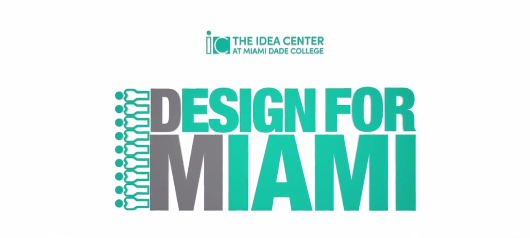
How design thinking can help build an even better Miami

Mention “design” and the word probably sparks ideas about objects, aesthetics and function.
Design thinking is about creative doing.
Developed over the past 40 years, it applies the principles of design to ways of working a particular challenge, emphasizing empathy with the users, outside-the-box thinking, prototyping and testing (with a generous tolerance of failure). It also favors collaboration and a loose but determined building process over notions of a lone genius coming up with the breakthrough idea in a eureka moment. The design thinking process has been used by leading companies, including Apple, AirBnb, and Nike, and has been embraced by Knight Foundation, which has integrated human-centered design into its own work, funded training for many of its partners, and suported initiatives to disseminate the principles.
“Design thinking is a process for innovation, or you can also call it a problem solving strategy,” says Ariel Raz, learning experience designer at Stanford University’s d.School, which has received support from Knight Foundation to cultivate design thinking among media and civic organizations. “It can be applied to many different fields. Its application is almost unbounded. There are certain problems to which it applies more effectively than others, but you can apply it to business, to healthcare or to education.”
Raz will discuss design thinking at The Idea Center at Miami Dade College, today at 5:30 p.m. The event is free and open to the public. The talk will also serve as an introduction for “Design for Miami,” a 12-week program The Idea Center will offer this fall, beginning Sept. 6. Mariana Rego, co-founder and partner at DTM Studio, and Durel Coleman, founder of DC Design, will lead the course, which is geared to working professionals, social entrepreneurs and Miami Dade College students. The Idea Center is funded in part by Knight Foundation.
“As an innovation and entrepreneurship center, this kind of thinking is a first step for any innovation journey for any entrepreneur,” said Leando Finol, executive director of The Idea Center. “Design thinking gives you the tools to put yourself in the user’s shoes, understand what are they trying to get done and then, based on those insights, decide the right product or service.” In fact, says Finol, “the Design for Extreme Affordability course at Stanford University is set up to build products and services for people living [on an income of] one dollar a day around the world. We are taking a kind of a similar approach, but targeting Miami.”
It’s an approach that was applied, for example, to address high mortality rate among premature and low weight babies in developing countries and the high cost of incubators, notes Raz. Responding to the challenge, a team of graduates of the Design for Extreme Affordability set out to develop low-cost baby incubators in Nepal, in 2007.
Applying the principles of design thinking, the team first immersed itself in the situation in Kathmandu, visiting the hospital and then the rural areas. From what they learned – the incubators were in the city; the majority of the premature births were in the rural countryside, the moms, having to tend to work and family, would not leave the infants out of sight, overnight – “the team had to redefine the problem. It wasn’t just about a cheaper baby incubator; it was about where the baby incubator was,” says Raz. The final product, after several rounds of prototyping, “was something like a baby sleeping bag,” and substantially cheaper than the conventional equipment used for keeping babies warm. The Stanford team has since incorporated as Embrace, a nonprofit organization.
“The teams in Miami are going to be building products and services for people living on minimum wage,” says Finol. “So instead of traveling to Haiti or Ghana they might be visiting neighborhoods like Little Haiti, Overtown or Little Havana.”
“This is an action-oriented program,” he emphasizes. “So we’re going to have three types of projects: around education, transportation and health care, three key challenges that keep people on minimum wage. There’s going to be real world application of innovation.”
Design for Miami will meet twice a week from 6:30 p.m. – 8:30 p.m., Tuesdays and Thursdays. There will also be work outside of class as part of a team. The deadline for registration is Aug. 29 and there is a limit of 20 students.
Fernando González is a Miami-based arts and culture writer. He can be reached via email at [email protected].
For more visit ideacenter.co and follow @ideacentermdc on Twitter.
Recent Content
-
Communitiesarticle ·
-
Communitiesarticle ·
-
Communitiesarticle ·


